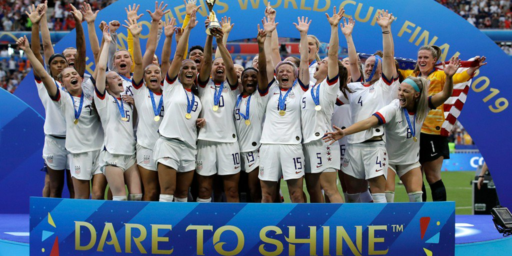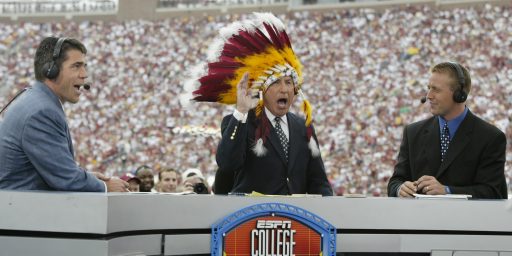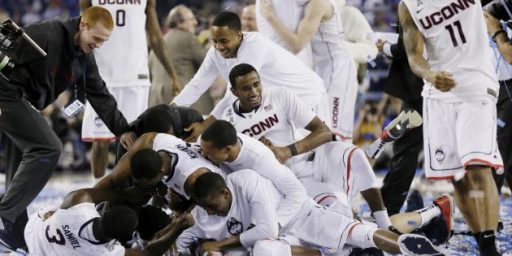Five People of Seven Million Picked Right Final Four
NYT reporter Michael Schmidt says not to feel bad about blowing your NCAA brackets this year. You are not alone.
Know anyone who has the Final Four intact in the office pool? No way.
After all, not one top-seeded team made it. The last time that happened was 1980. Who could have picked the Patriots — not Tom Brady & Company, but the ones from George Mason?
Was there a secret to making sense of possibly the most unpredictable N.C.A.A. tournament? For Russell Pleasant, a 46-year-old software engineer from Omaha, it took a lucky mistake. When he filled out his bracket earlier this month, he thought George Washington would reach this weekend’s Final Four. Instead, he ended up picking George Mason, round after round after round, all the way to Indianapolis. Now, he finds himself a rare survivor among millions of broken hearts with busted brackets across the nation. In ESPN.com’s 2006 Men’s College Basketball Tournament Challenge, Pleasant had one of the four entries among three million with U.C.L.A., Louisiana State, Florida and George Mason in the Final Four.
Last season, 4,172 people picked all four teams in ESPN.com’s pool. But last year’s Final Four featured a more predictable lineup: two top-seeded teams, North Carolina and Illinois; a fourth-seeded team, Louisville; and a fifth-seeded team, Michigan State. At cbs.sportsline.com, none of the two million brackets submitted this year had all four teams. In the Yahoo Sports pool, just one of more than a million entered had all four.
Even with the ridiculous number of upsets this year, I would have figured dozens of people would have gotten the Final Four right just through the law of large numbers. Five people out of seven million? Wow.
Update: Josh Lewin is currently in 4th place in ESPN’s pool. Sadly, he picked UConn, eliminated by George Mason this weekend, to win the whole thing.
crosspost from OTB Sports





Assuming that it was all random chance (which is of course an absurd starting point), then for a 64 team tournament (lets toss out the ‘play in’ game), then picking the final four randomly and having them win would look like this.
You would have a 4 in 32 chance of your ‘random 4’ teams winning the first round. Then a 4 in 16 chance for the next round. Then a 4 in 8 chance for the third round. That is 0.125 * 0.25 * 0.5 = 0.015625 or a 1.5625% chance of randomly picking the right people. This would mean that out of 256 random picks, you would expect one of them to get the right set of four.
So this would be a case where a room full of monkeys randomly picking final four contestants would seem to outperform millions of enthusiasts using their best basketball analysis skills.
I don’t think you did the math right. The chance of all four of your final four teams making it to the second round would be (1/2)^4 if they were picked randomly. The odds of picking all final four teams correctly this way would be 1 in 65,536.
Brian,
I was thinking in terms of picking 4 winners out of the first 32 games, then 4 winners out of the next round of 16 games, etc.
If you just start with a totally random selection by picking names out of a hat, then you would have a 1/64 chance for the first team. A 1/63 chance for the second team (since you have a reduce pool). A 1/62 for the third team and then a 1/61 for the final team.
So getting all of those percentages right would be 1/64*1/63*1/62*1/61 which comes out to 0.00000065578. Or 0.00000065578% chance. So the random picking would be a 1 in 15,249,024 chance. Which would reverse my earlier position and say that being able to identify the difference between a basketball and a banana does increase your odds of getting it right (given the several right guesses out of pools of less than 15 million).
Doing 1/64 * 1/63 etc. ignores the realities of the tournament. Not all combinations can be in the final four. Only one team from each region can be there. This greatly changes the odds.
In each round, each team selected has a 1/2 chance of winning. So the odds of correctly picking a round are (1/2)^4. Over four rounds, this becomes (1/2)^16, or 1 over 65,536.
Done another way, there is a 1/16 chance of picking the final four team in the region. The odds are (1/16)^4, which is also 1 over 65,536.
John — It’s not like drawing lottery numbers. The teams aren’t all playing each other. You have 4 regions, and each team is assigned to play one certain other team in the first round.
With random chance, each team has a 1/2 chance of winning each game. To get to the final four, a team has to do that four times, so you’d have a 1 in 16 chance in each region. Or stated differently, each region has 16 teams and only 1 is going to win the region, so a 1 in 16 chance in each region.
Then with 4 regions, it’s 1/16 to the 4th power. That gets you to 1 in 65,536
Sorry guys, I spent too long doing other things (working) between writing and posting, so Brian beat my remarkably similar explanation.
You are right Denise and Brian. So we are back to six million monkeys picking teams (sorted into the regional groupings) would have had about an order of magnitude (100) more correct picks compared to what the on-line pools are showing (five correct picks out of six million).
Thanks for taking the time to set me right and remind me why I only took one class in statistics 20 years ago.
Math makes me want to run screaming from the room. I couldn’t even tell you what the chances are my math skills suck so badly.
I do admit I like the fact that the tournament is more competitive now-its kind of nice to see four teams in the final four that weren’t supposed to be there.
Yeah, I applied last year’s logic as a typical logic this year, too. I predicted two top seeds, and two lesser seeds. I have no teams left.
“I do admit I like the fact that the tournament is more competitive now-its kind of nice to see four teams in the final four that werenâ??t supposed to be there.”
Just Me — I agree. I was thinking the other day about why I hadn’t heard a thing about the women’s tournament. Then just this morning I saw who was in the final four: Duke, UNC, Tennessee and UConn. Booorrrriiinnnggg!
That’s obviously not the whole reason why the women’s tournament is less popular (even than it was a few years ago), but I think it’s part of it.